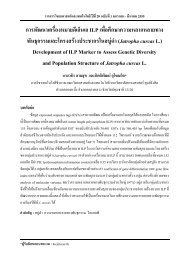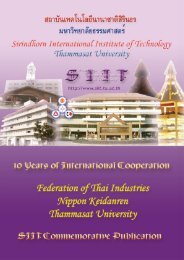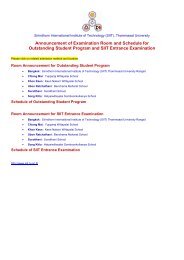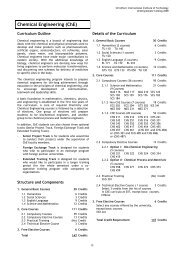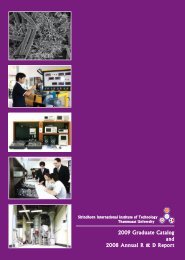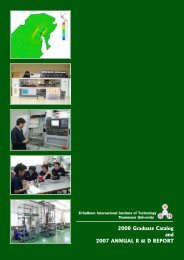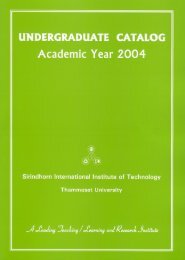2007 Graduate Catalog and 2006 Annual R & D Report - Sirindhorn ...
2007 Graduate Catalog and 2006 Annual R & D Report - Sirindhorn ...
2007 Graduate Catalog and 2006 Annual R & D Report - Sirindhorn ...
Create successful ePaper yourself
Turn your PDF publications into a flip-book with our unique Google optimized e-Paper software.
<strong>2007</strong> <strong>Graduate</strong> <strong>Catalog</strong> <strong>and</strong> <strong>2006</strong> <strong>Annual</strong> R & D <strong>Report</strong><br />
<strong>Sirindhorn</strong> International Institute of Technology (SIIT)<br />
Department of Common <strong>and</strong> <strong>Graduate</strong> Studies<br />
Faculty Members <strong>and</strong> Research Interests, <strong>2007</strong><br />
Dr. Alice Sharp<br />
Assistant Professor<br />
B.Sc. in Biology, Chiang Mai University, Thail<strong>and</strong><br />
M.Sc. in Environmental Risk Assessment, Chiang Mai University, Thail<strong>and</strong><br />
M.Sc. in Natural Resource Management, Hiroshima University, Japan<br />
Ph.D. in Natural Resource Management, Hiroshima University, Japan<br />
Areas of Specialization: Community based natural resource management, Environmental Impact Assessment,<br />
Pollution monitoring.<br />
Research Interests:<br />
Community Based Environmental Protection<br />
(CBEP)<br />
CBEP is a new approach to environmental protection.<br />
Traditionally, environmental protection programs have<br />
focused on the comm<strong>and</strong> <strong>and</strong> control approach,<br />
which have been very effective at reducing point<br />
source pollution <strong>and</strong> improving environmental quality.<br />
However, some environmental problems, such as<br />
non-point source pollution are less amenable to these<br />
programs. CBEP will supplement <strong>and</strong> complement<br />
the traditional environmental protection approach by<br />
focusing on the health of an ecosystem <strong>and</strong> the<br />
behavior of humans that live in the ecosystem’s<br />
boundaries. This study is aiming to 1) comprehensively<br />
identify local environmental concerns, 2) set<br />
priorities <strong>and</strong> goals that reflect overall community<br />
concerns, <strong>and</strong> 3) develop comprehensive, long-term<br />
solution to environmental problems.<br />
Products Life-Cycle Assessment (LCA)<br />
Life-cycle assessment (LCA) is used to quantify the<br />
environmental inputs <strong>and</strong> outputs of a product or<br />
process, from the mining of raw materials, through<br />
production, distribution, use <strong>and</strong> reuse or recycling, to<br />
final disposal. There are two main stages of LCA:<br />
inventory analysis <strong>and</strong> impact assessment. Inventory<br />
analysis involves the quantification of environmental<br />
inputs <strong>and</strong> outputs throughout a product or process’s<br />
lifetime. The inventory analysis is aiming to identify a<br />
list of pollutants that may have an impact on the<br />
environment. The purpose of the impact assessment<br />
is to aggregate <strong>and</strong> evaluate the potential<br />
environmental impacts identified in the inventory. This<br />
study will be focusing on particular kinds of waste<br />
which have high potential to be a major environmental<br />
problem in the future, mobile phone <strong>and</strong> its batteries,<br />
as an example in order to develop waste<br />
management plan <strong>and</strong> minimize the amount of waste<br />
before h<strong>and</strong>.<br />
Waste Management<br />
Waste management is one of the major long-term<br />
problems in our society. Cost-effective, environmentally<br />
sound management of wastes continues to<br />
be an unstable issue, the solution of which must<br />
integrate science, technology, individual awareness,<br />
<strong>and</strong> policy. Waste management begins with<br />
underst<strong>and</strong>ing the complete <strong>and</strong> detailed physical,<br />
chemical, <strong>and</strong> biological characteristics of the waste<br />
in question. This underst<strong>and</strong>ing is crucial to<br />
successful utilization or environmentally sound<br />
disposal measures. Additionally, waste management<br />
enables us to predict what is in a material, how much<br />
is there, how it may leach out, <strong>and</strong> how it will<br />
ultimately impact the environment.<br />
Dr. Jeffrey Frank Webb<br />
Assistant Professor (Joined SIIT in October <strong>2006</strong>)<br />
B.Sc. (Honors) in Applied Physics, Portsmouth University, Engl<strong>and</strong>, UK<br />
Ph.D. in Physics, University of Strathclyde, Scotl<strong>and</strong>, UK<br />
Areas of Specialization: Theoretical studies of bulk <strong>and</strong> thin-film properties of ferroelectric materials; Linear<br />
<strong>and</strong> non linear optics of ferroelectrics, Nanotechnology <strong>and</strong> nanoscience: Theoretical studies <strong>and</strong> modelling of<br />
nanostructures such as quantum dot <strong>and</strong> wire structures; Nanoscale device modelling.<br />
Research Interests:<br />
Ferroelectric Materials<br />
Phenomenological studies of ferroelectric materials<br />
using L<strong>and</strong>au-Devonshire-Ginzburg theory: The basis<br />
of this theory is that the free energy can be exp<strong>and</strong>ed<br />
in powers of the order parameter (often taken to be<br />
the polarization). Bulk properties are easily h<strong>and</strong>led<br />
with this approach, <strong>and</strong> by adding a gradient term to<br />
the free energy, finite size effects can also be studied.<br />
For example, the way that a thin-film ferroelectric<br />
influences the ferroelectric properties can be studied.<br />
This is of increasing importance technologically<br />
because of the use of thin-film ferroelectrics in<br />
ferroelectric r<strong>and</strong>om access memories.<br />
38




